目录1 set/ multiset 容器1.1 set基本概念1.2 set构造和赋值1.3 set大小和交换1.4 set插入和删除1.5 set查找和统计1.6 set和mult
简介:
本质:
set和multiset区别:
功能描述:创建set容器以及赋值
构造:
set<T> st; //默认构造函数:set(const set &st); //拷贝构造函数赋值:
set& operator=(const set &st); //重载等号操作符示例:
#include <set>
void printSet(set<int> & s)
{
for (set<int>::iterator it = s.begin(); it != s.end(); it++)
{
cout << *it << " ";
}
cout << endl;
}
//构造和赋值
void test01()
{
set<int> s1;
s1.insert(10);
s1.insert(30);
s1.insert(20);
s1.insert(40);
printSet(s1);
//拷贝构造
set<int>s2(s1);
printSet(s2);
//赋值
set<int>s3;
s3 = s2;
printSet(s3);
}
int main() {
test01();
system("pause");
return 0;
}

总结:
功能描述:
统计set容器大小以及交换set容器
函数原型:
size(); //返回容器中元素的数目empty(); //判断容器是否为空swap(st); //交换两个集合容器示例:
void printSet(set<int> & s)
{
for (set<int>::iterator it = s.begin(); it != s.end(); it++)
{
cout << *it << " ";
}
cout << endl;
}
//大小
void test01()
{
set<int> s1;
s1.insert(10);
s1.insert(30);
s1.insert(20);
s1.insert(40);
if (s1.empty())
{
cout << "s1为空" << endl;
}
else
{
cout << "s1不为空" << endl;
cout << "s1的大小为: " << s1.size() << endl;
cout << endl;
}
}
//交换
void test02()
{
set<int> s1;
s1.insert(10);
s1.insert(30);
s1.insert(20);
s1.insert(40);
set<int> s2;
s2.insert(100);
s2.insert(300);
s2.insert(200);
s2.insert(400);
cout << "交换前" << endl;
printSet(s1);
printSet(s2);
cout << endl;
cout << "交换后" << endl;
s1.swap(s2);
printSet(s1);
printSet(s2);
}
int main() {
test01();
test02();
system("pause");
return 0;
}
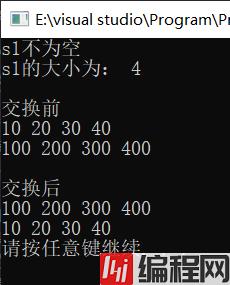
总结:
功能描述:
set容器进行插入数据和删除数据
函数原型:
示例:
#include <set>
void printSet(set<int> & s)
{
for (set<int>::iterator it = s.begin(); it != s.end(); it++)
{
cout << *it << " ";
}
cout << endl;
}
//插入和删除
void test01()
{
set<int> s1;
//插入
s1.insert(10);
s1.insert(30);
s1.insert(20);
s1.insert(40);
printSet(s1);
//删除
s1.erase(s1.begin());
printSet(s1);
s1.erase(30);
printSet(s1);
//清空
//s1.erase(s1.begin(), s1.end());
s1.clear();
printSet(s1);
}
int main() {
test01();
system("pause");
return 0;
}
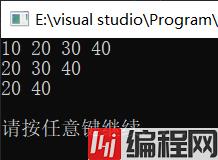
总结:
功能描述:
对set容器进行查找数据以及统计数据
函数原型:
find(key); //查找key是否存在,若存在,返回该键的元素的迭代器;若不存在,返回set.end();count(key); //统计key的元素个数示例:
#include <set>
//查找和统计
void test01()
{
set<int> s1;
//插入
s1.insert(10);
s1.insert(30);
s1.insert(20);
s1.insert(40);
//查找
set<int>::iterator pos = s1.find(30);
if (pos != s1.end())
{
cout << "找到了元素 : " << *pos << endl;
}
else
{
cout << "未找到元素" << endl;
}
//统计
int num = s1.count(30);
cout << "num = " << num << endl;
}
int main() {
test01();
system("pause");
return 0;
}
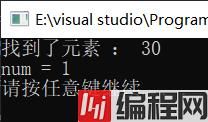
总结:
学习目标:
掌握set和multiset的区别
区别:
第7行的pair<set<int>::iterator, bool>是怎么来的呢?首先将鼠标停留在第七行的insert上,点击鼠标右键,选择转到定义,会发现insert函数的返回类型是_Pairib,如下图

再将鼠标停留在_Pairib上,点击鼠标右键,选择转到定义,就会发现_Pairib是pair,里面有两个数据,第一个数据是迭代器

示例:
#include <set>
//set和multiset区别
void test01()
{
set<int> s;
pair<set<int>::iterator, bool> ret = s.insert(10);
if (ret.second) {
cout << "第一次插入成功!" << endl;
}
else {
cout << "第一次插入失败!" << endl;
}
ret = s.insert(10);
if (ret.second) {
cout << "第二次插入成功!" << endl;
}
else {
cout << "第二次插入失败!" << endl;
}
//multiset
multiset<int> ms;
ms.insert(10);
ms.insert(10);
for (multiset<int>::iterator it = ms.begin(); it != ms.end(); it++) {
cout << *it << " ";
}
cout << endl;
}
int main() {
test01();
system("pause");
return 0;
}

总结:
学习目标:
主要技术点:
仿函数(重载了运算符或小括号),可以改变排序规则示例一: set存放内置数据类型
如果你想要set中的元素按自己想要的顺序进行排序,那么就要在没有插入元素前告诉set排序规则
#include <set>
class MyCompare //不一定非要是MyCompare,随便命名
{
public:
//第一个()代表重载小括号,第二个()代表函数的参数列表
bool operator()(int v1, int v2) {
//降序,也就是想要第一个数大于第二个数
return v1 > v2;
}
};
void test01()
{
set<int> s1;
s1.insert(10);
s1.insert(40);
s1.insert(20);
s1.insert(30);
s1.insert(50);
//默认从小到大
for (set<int>::iterator it = s1.begin(); it != s1.end(); it++) {
cout << *it << " ";
}
cout << endl;
//指定排序规则,<>肯定是放数据类型,不能放函数名,而仿函数Mycompare本质上就是一个类型
//插入数之后就没办法排序了,插入之前就要指定排序规则
set<int,MyCompare> s2;
s2.insert(10);
s2.insert(40);
s2.insert(20);
s2.insert(30);
s2.insert(50);
for (set<int, MyCompare>::iterator it = s2.begin(); it != s2.end(); it++) {
cout << *it << " ";
}
cout << endl;
}
int main() {
test01();
system("pause");
return 0;
}
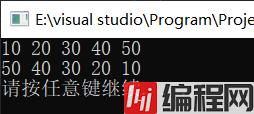
示例二: set存放自定义数据类型
#include <set>
#include <string>
class Person
{
public:
Person(string name, int age)
{
this->m_Name = name;
this->m_Age = age;
}
string m_Name;
int m_Age;
};
class comparePerson
{
public:
bool operator()(const Person& p1, const Person &p2)
{
//按照年龄进行排序 降序
return p1.m_Age > p2.m_Age;
}
};
void test01()
{
set<Person, comparePerson> s;
Person p1("刘备", 23);
Person p2("关羽", 27);
Person p3("张飞", 25);
Person p4("赵云", 21);
s.insert(p1);
s.insert(p2);
s.insert(p3);
s.insert(p4);
for (set<Person, comparePerson>::iterator it = s.begin(); it != s.end(); it++)
{
cout << "姓名: " << it->m_Name << " 年龄: " << it->m_Age << endl;
}
}
int main() {
test01();
system("pause");
return 0;
}
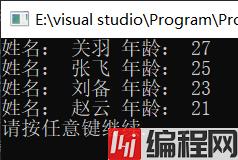
到此这篇关于c++中set/multiset容器详解的文章就介绍到这了,更多相关C++ set/multiset容器内容请搜索编程网以前的文章或继续浏览下面的相关文章希望大家以后多多支持编程网!
--结束END--
本文标题: C++中set/multiset容器详解(附测试用例与结果图)
本文链接: https://lsjlt.com/news/195391.html(转载时请注明来源链接)
有问题或投稿请发送至: 邮箱/279061341@qq.com QQ/279061341
2024-03-01
2024-03-01
2024-02-29
2024-02-29
2024-02-29
2024-02-29
2024-02-29
2024-02-29
2024-02-29
2024-02-29
回答
回答
回答
回答
回答
回答
回答
回答
回答
回答
0